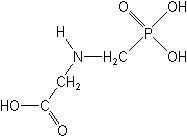Products >> Herbicides >> Glyphosate
Glyphosate
Glyphosate 95%TC
Glyphosate 62%SL
Glyphosate 41%SL
Herbicide
HRAC G WSSA 9; glycine derivative
For a general review, see "Glyphosate, A Unique Global Herbicide".

NOMENCLATURE
Common name glyphosate (BSI, E-ISO, (m) F-ISO, ANSI, WSSA, JMAF)
IUPAC name N-(phosphonomethyl)glycine
Chemical Abstracts name N-(phosphonomethyl)glycine
CAS RN [1071-83-6] EEC no. 213-997-4 Development codes MON-0573
(Monsanto); CP 67573 (Monsanto)
glyphosate-ammonium
CAS RN [40465-66-5] monoammonium salt; [69254-40-6] diammonium salt;
[114370-14-8] unspecified ammonium salt Development codes MON 8750
(Monsanto)
glyphosate-isopropylammonium
CAS RN [38641-94-0] EEC no. 254-056-8 Development codes MON 0139
(Monsanto); MON 77209 (Monsanto)
glyphosate-sodium
CAS RN [34494-03-6] Development codes MON 8722 (Monsanto)
glyphosate-trimesium
IUPAC name trimethylsulfonium N-(phosphonomethyl)glycinate
Chemical Abstracts name N-(phosphonomethyl)glycine trimethylsulfonium
salt
Other names sulfosate CAS RN [81591-81-3] Development codes SC 0224;
ICIA0224 (ICI)
APPLICATIONS
Biochemistry Inhibits 5-enolpyruvylshikimate-3-phosphate synthase
(EPSPS), an enzyme of the aromatic acid biosynthetic pathway. This
prevents synthesis of essential aromatic amino acids needed for
protein biosynthesis. Mode of action Non-selective systemic herbicide,
absorbed by the foliage, with rapid translocation throughout the
plant. Inactivated on contact with soil. Uses Control of annual
and perennial grasses and broad-leaved weeds, pre-harvest, post-planting/pre-emergence
and in stubble, in cereals, peas, beans, oilseed rape, flax and
mustard, at c. 1.5-2 kg/ha; as a directed spray in vines and olives,
at c. 4.3 kg/ha; in orchards, pasture, forestry and industrial weed
control, at c. 4.3 kg/ha. As an aquatic herbicide, at c. 2 kg/ha.
Formulation types SG; SL. Compatibility Mixing with other herbicides
may reduce the activity of glyphosate. Selected tradenames: 'Rodeo'
(isopropylammonium salt) (Monsanto); 'Roundup' (isopropylammonium
salt) (Monsanto); 'Sting' (isopropylammonium salt) (Monsanto); 'Touchdown'
(trimesium salt) (Syngenta); 'Asset' (isopropylammonium salt) (Ancom);
'Barbarian' (Barclay); 'Caoganlin' (Shenzhen Jiangshan); 'Glion'
(Defensa); 'Glistar' (isopropylammonium salt) (ICN Hungary); 'Glycel'
(isopropylammonium salt) (Excel); 'Glyphogan' (isopropylammonium
salt) (Makhteshim-Agan); 'Glyphomax' (isopropylammonium salt) (Dow
AgroSciences); 'Glyphotox' (Aimco); 'Mamba' (isopropylammonium salt)
(Dow AgroSciences); 'Pilarsato' (Pilarquim); 'Rinder' (Inquiport);
'Rondo' (isopropylammonium salt) (Reposo); 'Rophosate' (Rotam);
'Sanos' (isopropylammonium salt) (Sanonda); 'Seccherba' (Agrimix);
'Taifun' (isopropylammonium salt) (Feinchemie Schwebda); mixtures:
'Rebin GT' (+ butafenacil) (glyphosate as isopropylammonium salt)
(Syngenta); 'Oriflam' (+ amitrole) (CFPI Nufarm)
ANALYSIS
Product analysis by hplc (AOAC Methods, 1995, 983.10; CIPAC Handbook,
1985, 1C, 2130). Residues determined by gc (Pestic. Anal. Man.,
1979, II ) or by hplc with o-phthalaldehyde post-column reaction
specific for primary amines (J. Agric. Food Chem., 34(6), 955-960
(1986)). In environmental water, by hplc determination by o-phthalaldehyde
post-column reaction system (AOAC Methods, 1995, 991.08, 10.6.18).
MAMMALIAN TOXICOLOGY
Reviews FAO/WHO 47, 49, 80, 82 (see part 2 of the Bibliography).
Oral Acute oral LD50 for rats 5600, mice 11 300, goats 3530 mg/kg.
Skin and eye Acute percutaneous LD50 for rabbits >5000 mg/kg.
Eye irritant; non-irritating to skin (rabbits). Inhalation LC50
(4 h) for rats >4.98 mg/l air. NOEL In 2 y feeding trials, no
ill-effects were observed in rats receiving 410 mg/kg diet daily
(average) and, in 1 y feeding trials, no ill-effects were observed
in dogs receiving 500 mg/kg daily (highest dose treated). ADI (JMPR)
0.3 mg/kg b.w. [1986, 1997] (for sum of glyphosate and its metabolite
AMPA). Water GV Unnecessary to recommend a guideline value because
not hazardous to health at concentrations normally found in drinking
water. Other Not mutagenic, not carcinogenic, not teratogenic, not
neurotoxic. No adverse effects on reproduction. Toxicity class WHO
(a.i.) III (Table 5); EPA (formulation) III EC hazard (Xi; R41)
glyphosate-ammonium
Oral Acute oral LD50 for rats 4613 mg/kg. Skin and eye Acute percutaneous
LD50 for rabbits >5000 mg/kg. Slight eye irritant; not a skin
irritant (rabbits). Inhalation LC50 >1.9 mg/l air. Toxicity class
EPA (formulation) III
glyphosate-isopropylammonium
Oral Acute oral LD50 for rats >5000, goats 5700 mg/kg. Skin and
eye Acute percutaneous LD50 for rabbits >5000 mg/kg. Slight eye
irritant; not a skin irritant (rabbits). Inhalation LC50 (4 h) for
rats >1.3 mg/l air. NOEL In a 6 mo capsule trial, no ill-effects
were observed in dogs receiving 300 mg/kg daily (highest dose treated).
Toxicity class EPA (formulation) III
glyphosate-sodium
Skin and eye Acute oral LD50 for rats >5000 mg/kg. Slight eye
irritant; not a skin irritant (rabbits).
glyphosate-trimesium
Oral Acute oral LD50 for male rats 748, female rats 755, mice 1250
mg/kg. Skin and eye Acute percutaneous LD50 for rabbits >2000
mg/kg. Inhalation LC50 (4 h) for rats 6.2 mg/l air. NOEL 100 mg/kg
daily. No teratogenic effect observed. ADI 25 mg/kg b.w. EC hazard
(Xn; R22)
ENVIRONMENTAL FATE
EHC 159 (WHO, 1994). Animals In mammals, following oral administration,
glyphosate is very rapidly excreted unchanged and does not bioaccumulate.
Plants Slowly metabolised to aminomethylphosphonic acid ([1066-51-9]),
which is the major plant metabolite. Soil/Environment In soil (field),
DT50 3-174 d, depending on edaphic and climatic conditions. In water,
DT50 varies from a few to 91 d. Photodegradation in water occurs
under natural conditions, DT50 £28 d; no substantial photodegradation
in soil was recorded over 31 d. In a lab. whole system with water
and sediment, DT50 £14 d (aerobic), 14-22 d (anaerobic). The
major metabolite in soil and water is aminomethylphosphonic acid.